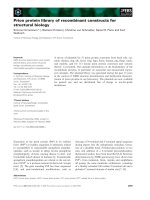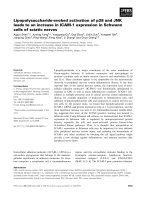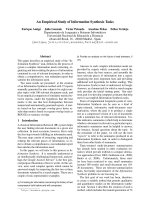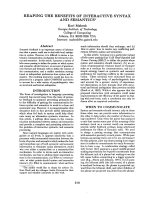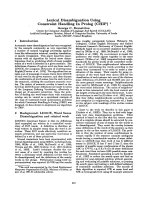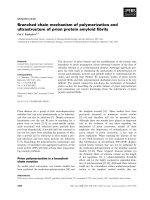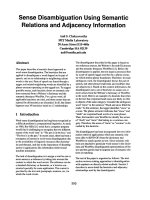Báo cáo khoa học: "Lexical Disambiguation: Sources of Information and their Statistical Realization" docx
Bạn đang xem bản rút gọn của tài liệu. Xem và tải ngay bản đầy đủ của tài liệu tại đây (199.76 KB, 2 trang )
Lexical Disambiguation: Sources of Information and their Statistical
Realization
Ido Dagan *
Computer Science Department, Technion, Haifa, Israel
and
IBM Scientific Center, Technion City, Haifa, Israel
Abstract
Lexieal disambiguation can be achieved using differ-
ent sources of information. Aiming at high perfor-
mance of automatic disambiguation it is important
to know the relative importance and applicability of
the various sources. In this paper we classify sev-
eral sources of information and show how some of
them can be achieved using statistical data. First
evaluations indicate the extreme importance of local
information, which mainly represents lexical associ-
ations and seleetional restrictions for syntactically
related words.
1 Disambiguation Sources
The resolution of lexical ambiguities in unrestricted
text is one of the most difficult tasks of natural lan-
guage processing. In machine translation we are
confronted with the related task of target word se-
lection - the task of deciding which target language
word is the most appropriate equivalent of a source
language word in context. In contrast to compu-
tational systems, humans seem to select the correct
sense of an ambiguous word without much effort and
usually without even being aware to the existence
of an ambiguous situation. This fact naturally led
researches to point out various sources of informa-
tion which may provide the necessary cues for dis-
ambiguation, either for humans or machines. The
following paragraphs classify these sources into two
major types, based on either understanding of the
text or frequency characteristics of it.
One kind of information relates to the under-
standing of the meaning of the text, using semantic
and pragmatic knowledge and applying reasoning
mechanisms. The following sentences, taken from
foreign news sections in the Israeli Hebrew press,
demonstrate how different levels of understanding
can provide the disambiguating information.
(1) hayer ha-bayit ha-'elyon shel ha-parlament ha-
*This
research was partially supported by grant number
120-7'41 of the Israel Council for Research and Development
341
sovieti zaka be-monitin ke-hoker shel ha-sh_hitut
be-kazahstan.
This sentence translates into English as:
(2) The member of the upper house of the soviet
parliament acquired a reputation as an investi-
gator of the corruption in Kazakhstan.
The two most frequent senses of the ambiguous noun
'_hayer' correspond to the English words 'friend' and
'member'. In the above example, the information for
selecting the correct sense is provided by the seman-
tic knowledge that 'a house of parliament' typically
has members but not friends. Computationally this
kind of information is usually captured by a shal-
low semantic model of selectional restrictions. In
other cases, such as example (3), it is necessary to
use deeper understanding of the text, which involves
some level of reasoning:
(3) be-het'em le-hoq ha-hagira ha-hadash tihye le-
kol ezrah.h_ sovieti ha-zkut ha-otomatit lekabel
darkon bar tokef le-hamesh shanim.
This sentence translates into English as:
(4) According to the new emigration bill every so-
viet citizen will have the automatic right to re-
ceive a passport valid for five years.
The Hebrew word 'hagira' is used for the two sub-
senses 'emigration' and 'immigration'. In order to
make the correct selection it is necessary to reason
that since the soviet bill relates to soviet citizens
then it concerns with leaving the country rather
than entering it.
Another kind of information source, which was
originally raised in the psycholinguistic literature,
relates to the relative frequencies of word senses
and associations between word senses. These fac-
tors were shown to play an important role in lexical
retrieval, and were suggested as relevant for lexical
disambiguation [4, 3]. Hanks [1], for example, lists
different words associated with the two senses of the
word 'bank', such as money, notes, account, invest-
ment etc. versus river, swim, boat etc.
Aiming for high performance in automatic disam-
biguation, it is important to know (a) what is the
portion of ambiguous cases in running text which
can be resolved by each source of information and
(b) how to set preferences among these sources when
they provide contradicting evidence.
2 Statistical Information
A tempting starting point for answering the above
questions is to use various types of statistical data
about word senses and evaluate their contribution
to disambiguation. In recent years, statistical data
were used successfully for other linguistic tasks.
The process of acquiring statistical data is usually
faster and more standard and objective than manual
construction of knowledge. This makes such data
suitable for the evaluation task we are confronted
with. The following paragraphs describe the kinds
of statistics we use and explain how they reflect dif-
ferent types of disambiguating information.
In another paper [2] we describe a new multilin-
gual approach in which we gather statistics about
senses of amhiguous words of one language using
a corpus of a different language. For example,
the different word associations for the two senses
of 'bank' will be identified in a Hebrew corpus,
where a distinct word is used for each of the senses.
This method enabled us to collect statistics from
very large corpora without manually tagging the oc-
currences of the ambiguous words with their word
senses. In our first experiment we have examined
about one hundred examples of ambiguous Hebrew
words which were selected randomly from foreign
news sections in the Israeli press. For each sense
of a Hebrew word we have collected statistics (in
an English corpus) on its absolute frequency and its
cooccurrences with other words that were syntacti-
cally related with it in the example sentence.
Two kinds of statistics were maintained. One
statistic was the number of times in which the re-
lated words were identified in the corpus having the
same syntactic relation as in the example sentence.
This kind of statistic reflects both sehctional restric-
tions, like the relation between 'member' (versus
'friend') and 'a house of parliament', and also word
associations, like the association between 'member'
and 'reputation', which is stronger than the associ-
ation between 'friend' and 'reputation'. In the first
case we expect a null frequency for the semantically
illegal alternative, while in the second case we ex-
pect the difference in frequencies to represent the
different degrees of association between the compet-
ing alternatives and their surrounding context. In
getting this syntactically based statistic we are of
course limited by the coverage and the accuracy of
the parser, thus getting smaller and somewhat noisy
counts relative to the real counts in the corpus.
A second and more robust statistic is obtained
by counting the number of times in which the two
words cooccurred within a limited distance [1]. For
instance, the words 'member' and 'acquire' cooc-
curred 81 times in the corpus within a maximal dis-
tance of 7 words. This statistic is partly correlated
with the first statistic, capturing also cases that were
missed by the parser, but it also reflects lexical as-
sociations between words that tend to cooccur ad-
jacently without having a specific syntactic relation
between them. For instance, in one of our examples
the word 'hatsba'ah', which means either 'voting' or
'indication', cooccurred in the same sentence with
the word 'bhirot' (elections). We expect that the
adjacency statistic will indicate the strong associa-
tion between 'voting' and 'elections', and thus would
prefer 'voting' as the appropriate sense.
The results reported in [2] together with further
examination of our data have clearly indicated some
interesting facts. In the vast majority of cases
enough disambiguating information is provided by
the immediate context, especially by syntactically
related words. The absolute frequency of a word
sense does not seem very useful, since it usually can
he overridden successfully by the local context. An
encouraging fact is that deep understanding of the
text is rarely necessary, and seems to be required
only for very delicate distinctions such as in exam-
ple (3). In future work we intend to further analyze
our data and test more examples, so that we can
reach more decisive and quantitive conclusions. We
believe that such conclusions will contribute to im-
prove lexical disambiguation in broad coverage sys-
tems.
References
[1]
[2]
Church, K. W., and Hanks, P., Word associa-
tion norms, mutual information, and Lexicog-
raphy, Computational Linguistics, vol. 16(1),
22-29 (1990).
Dagan, Ido, Alon Ital and Ulrike Schwall, Two
languages are more informative than one, sub-
mitted to ACL-91.
[3]
[4]
Meyer, D., Schvaneveldt, R. and Ruddy, M.,
Loci of contextual effects on visual word-
recognition, in P. Rabbitt and S. Dornic (eds.),
Attention and Performance V, Academic Press,
New-York, 1975.
Simpson, Greg B. and Curt Burgess, Implica-
tions of lexical ambiguity resolution for word
recognition, in Small, S. L., G. W. Cotrell and
M. K. Tanenhaus, (eds.) Lexicai Ambiguity Res.
olution, Morgan Kaufman Publishers, 1988.
342
